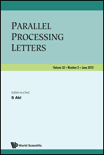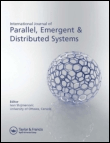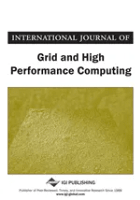
DISTRIBUTED COMPUTING
Scope & Guideline
Elevating Knowledge in Computational Excellence
Introduction
Aims and Scopes
- Distributed Algorithms:
Research that explores the design, analysis, and implementation of algorithms that operate in distributed systems, focusing on efficiency and effectiveness in problem-solving. - Fault Tolerance and Byzantine Agreement:
Studies related to achieving consensus and reliability in the presence of failures, particularly in environments with malicious actors, emphasizing Byzantine fault tolerance. - Network Models and Communication Complexity:
Investigations into the properties of various network models, including the CONGEST model, and the complexities associated with communication in distributed settings. - Distributed Data Structures and Synchronization:
Development and analysis of data structures that can be efficiently utilized in distributed systems, including issues of synchronization and consistency. - Self-Stabilization and Dynamic Systems:
Research on systems that can recover from transient faults or changes in their environment, focusing on self-stabilizing protocols and algorithms. - Graph Algorithms in Distributed Settings:
Exploration of distributed algorithms for solving graph-related problems, including connectivity, coloring, and minimum spanning tree issues in various network topologies. - Cloud Computing and Resource Management:
Studies that integrate distributed computing principles with cloud computing, focusing on resource allocation, load balancing, and scalability.
Trending and Emerging
- Byzantine Consensus and Resilience:
A marked increase in research related to Byzantine consensus protocols highlights the growing importance of resilience in distributed systems, especially in the context of security and fault tolerance. - Self-Stabilizing and Adaptive Algorithms:
Emerging studies on self-stabilizing algorithms that adapt to changes in system state or network topology are gaining traction, showcasing a trend towards systems that can autonomously recover from faults. - Resource Allocation in Cloud and Edge Computing:
Research focusing on distributed computation within cloud and edge environments is trending, driven by the need for efficient resource management and scalability in modern computing infrastructures. - Asynchronous Communication Models:
The exploration of asynchronous communication models is on the rise, providing new insights into how distributed systems can operate effectively without relying on synchronized states. - Social Network Dynamics and Distributed Systems:
An emerging theme involves the study of opinion dynamics and information spread in social networks, linking distributed computing with social phenomena and complex systems.
Declining or Waning
- Traditional Synchronization Mechanisms:
Research focused on classical synchronization techniques, such as locks and semaphores, appears to be diminishing as more researchers explore lock-free and wait-free algorithms that enhance performance in distributed systems. - Static Network Models:
The interest in static network models is waning as the focus shifts towards dynamic and adaptive networks that better reflect real-world scenarios, including mobile and heterogeneous environments. - Basic Consensus Protocols:
While consensus remains a critical area, the basic consensus protocols are less frequently explored as researchers look to improve upon these fundamentals with more complex and optimized solutions, particularly in Byzantine contexts. - Locality-Based Algorithms:
The focus on locality in distributed algorithms is declining, as researchers increasingly consider global approaches that leverage the entire network rather than relying solely on localized interactions. - Single-Threaded Distributed Computation:
There is a noticeable decrease in research dedicated to single-threaded approaches in distributed systems, with a growing emphasis on parallel and concurrent processing techniques.
Similar Journals

JOURNAL OF SUPERCOMPUTING
Illuminating the Future of Computer ScienceJOURNAL OF SUPERCOMPUTING is a premier academic journal published by SPRINGER, situated in the Netherlands, that has made significant contributions to the fields of computer science, particularly in hardware and architecture, information systems, software, and theoretical computer science. With a robust publication history spanning from 1987 to 2024, this journal has cultivated a strong reputation, evidenced by its Category Quartiles ranking in the Q2 category across multiple relevant domains in 2023. The journal's Scopus rankings further underscore its influence, boasting a 78th percentile in mathematics and theoretical computer science, revealing the high quality of research disseminated within its pages. As vital discourse unfolds in the realm of supercomputing—where innovative techniques and technologies rapidly evolve—this journal serves as a crucial platform for researchers, professionals, and students to explore cutting-edge studies and build upon the foundations of knowledge in this dynamic field.

Frontiers of Computer Science
Pioneering Research for Tomorrow's TechnologyFrontiers of Computer Science is a leading peer-reviewed journal dedicated to advancing the field of computer science through the publication of high-quality research articles, reviews, and theoretical discussions. Published by HIGHER EDUCATION PRESS, this journal has gained significant recognition, currently boasting a prestigious impact factor and ranking in the Q1 quartile for both Computer Science (miscellaneous) and Theoretical Computer Science categories in 2023. With a focus on the intersection of computational theory and practical applications, it serves as a vital platform for researchers, professionals, and students alike who are eager to contribute to and stay updated with groundbreaking developments. The journal’s scope encompasses a wide range of topics, reflecting the diverse nature of computer science today. Operating from Beijing, China, it emphasizes Open Access, ensuring that vital research is readily available to the global academic community. With its convergence period spanning from 2013 to 2024, Frontiers of Computer Science remains committed to fostering innovation and scholarly dialogue that drives the future of technology.

IEEE Transactions on Signal and Information Processing over Networks
Advancing the Frontiers of Signal and Information Processing.IEEE Transactions on Signal and Information Processing over Networks, published by IEEE-INST ELECTRICAL ELECTRONICS ENGINEERS INC, stands at the forefront of innovation in the fields of signal processing, computer networks, and information systems. With an impressive track record since its inception in 2015, this journal boasts a notable impact factor, placing it in the prestigious Q1 category in its respective fields, including Signal Processing and Computer Networks & Communications. Researchers and professionals will benefit greatly from its rigorously peer-reviewed articles that present cutting-edge discoveries and methodologies relevant to the ever-evolving landscape of network technology. Although the journal does not currently offer open access options, it remains a vital resource for advanced study and application, ensuring that researchers can stay abreast of the latest developments and trends shaping the industry. With Scopus rankings highlighting its competitive standing, this publication is an essential platform for disseminating meaningful scholarly contributions and fostering collaboration within the global research community.

Theoretical Computer Science
Pioneering Insights in Computational FrameworksTheoretical Computer Science, published by Elsevier, serves as a pivotal platform in the field of computational theory, exploring the foundational aspects of computer science and mathematical logic since its inception in 1975. With both a print ISSN of 0304-3975 and an E-ISSN of 1879-2294, this journal is esteemed for its rigorous peer-review process and commitment to advancing knowledge in theoretical frameworks and algorithms. Positioned in the Q2 quartile for both Computer Science (miscellaneous) and Theoretical Computer Science categories, it ranks #124 out of 232 in general computer science and #73 out of 130 in theoretical computer science according to Scopus metrics, reflecting its significant influence and reach within the academic community. Researchers and professionals can access this journal through institutional subscriptions, providing a plethora of high-quality articles that contribute to ongoing debates and developments in the discipline. The journal's scope encompasses a wide array of topics, ensuring relevance across various subfields, thus making it an essential resource for anyone dedicated to furthering their understanding of theoretical computer science.

Parallel Processing Letters
Shaping the Future of Computational Architectures.Parallel Processing Letters is a notable academic journal published by World Scientific Publishing Co Pte Ltd, focusing on the dynamic fields of Computer Science, particularly in Hardware and Architecture, Software, and Theoretical Computer Science. Established in 1994, this journal provides a platform for the dissemination of cutting-edge research and developments in parallel processing and computational technologies. Despite its current Q4 ranking in multiple categories, Parallel Processing Letters plays an important role in fostering scholarly discussion and innovation within the computing community. With the ISSN 0129-6264 and E-ISSN 1793-642X, the journal is dedicated to maintaining rigorous academic standards while encouraging collaborative research conducive to the advancement of parallel processing systems. It serves as a valuable resource for researchers, professionals, and students seeking to deepen their understanding and gain insights into this rapidly evolving domain.

DISTRIBUTED AND PARALLEL DATABASES
Advancing the Frontiers of Database InnovationDistributed and Parallel Databases is a prestigious journal published by Springer, dedicated to advancing the field of database systems and distributed computing. With an ISSN of 0926-8782 and an E-ISSN of 1573-7578, this journal has been a prominent platform for disseminating significant research findings since its inception in 1993. The journal is recognized for its contributions across various dimensions of database technology, notably reflecting in its 2023 Quartile Rankings where it stands at Q3 in Hardware and Architecture and Software, while achieving a commendable Q2 in Information Systems and Management. With Scopus Ranking positioning it within the top half of key categories, the journal plays a crucial role in bridging theoretical and practical aspects of distributed database solutions. Although it does not currently offer open access options, it is widely accessible to institutions, making it an essential resource for researchers, professionals, and students keen on exploring the latest trends and innovations in the realm of distributed and parallel computing.

Science China-Information Sciences
Connecting Researchers for Transformative Insights.Science China-Information Sciences is a prestigious academic journal published by SCIENCE PRESS, dedicated to advancing knowledge in the field of information sciences and computer science. Established in China, the journal has gained a remarkable reputation, with a 2023 category quartile ranking of Q1 in Computer Science (miscellaneous) and an impressive Scopus rank of #16 out of 232 in General Computer Science, positioning it within the 93rd percentile. The journal embraces a broad spectrum of topics, from theoretical frameworks to practical applications, providing a platform for researchers, professionals, and students to disseminate their findings and engage with the latest advancements in the field. With open access options available, Science China-Information Sciences ensures that innovative research is accessible to a global audience, fostering collaboration and interdisciplinary dialogue. The journal not only reflects the evolving landscape of information sciences but also plays a pivotal role in shaping future research directions.

ACM Transactions on Parallel Computing
Driving Progress in Parallel and Distributed TechnologiesACM Transactions on Parallel Computing (ISSN: 2329-4949; E-ISSN: 2329-4957), published by the Association for Computing Machinery, stands as a pivotal journal in the field of computer science, particularly focusing on the advancements in parallel and distributed computing. With its convergence years spanning from 2014 to 2024, this journal serves as a significant platform for disseminating cutting-edge research, methodologies, and technologies that shape the future of computational theory, hardware architectures, and effective software solutions. Although it currently holds a Q3 category ranking in various subfields including Computational Theory and Mathematics, and Modeling and Simulation, it continues to attract researchers aiming to contribute to its growing impact in the field. The journal's commitment to fostering knowledge exchange makes it an essential resource for professionals and students eager to navigate the complexities of parallel computing. As the field evolves, ACM Transactions on Parallel Computing remains a critical reference point for innovative research and professional development in computer science.

International Journal of Parallel Emergent and Distributed Systems
Connecting Scholars and Practitioners in Cutting-edge ComputingInternational Journal of Parallel Emergent and Distributed Systems, published by Taylor & Francis Ltd, is a prestigious academic journal aimed at advancing the fields of parallel computing, distributed systems, and emergent technologies. With an ISSN of 1744-5760 and E-ISSN 1744-5779, this journal has been a vital resource for researchers and professionals since its inception in 2005. As a part of the Q3 category in Computer Networks and Communications and Q4 in Software, it reflects a growing interest and engagement in these critical areas of study, with Scopus rankings highlighting its significance in computer science. Although currently not an open-access journal, its comprehensive exploration of innovative methodologies, systems design, and distributed computing paradigms makes it essential reading for anyone involved in cutting-edge research and application development. The journal not only aims to disseminate novel insights but also serves as a platform to foster dialogue among practitioners and scholars alike, making it a cornerstone in the academic landscape of emergent technologies.

International Journal of Grid and High Performance Computing
Navigating the Complexities of Grid Computing for a Smarter TomorrowThe International Journal of Grid and High Performance Computing, published by IGI Global, is a vital resource in the fields of grid and high-performance computing. With an ISSN of 1938-0259 and an E-ISSN of 1938-0267, this journal has been dedicated to advancing knowledge and innovation since its inception in 2009, and is set to continue publishing groundbreaking research until 2024. Despite its current Q4 categorization in the Computer Networks and Communications field, the journal plays a crucial role in fostering interdisciplinary collaboration and sharing pioneering work that addresses the growing demands of computational performance and network efficiency. Although it does not offer open access, subscribers gain invaluable insights into contemporary issues and developments within this rapidly evolving discipline. The journal aims to attract original research articles, reviews, and case studies, making it an essential platform for researchers, professionals, and students keen on exploring the complexities of grid computing and its applications.